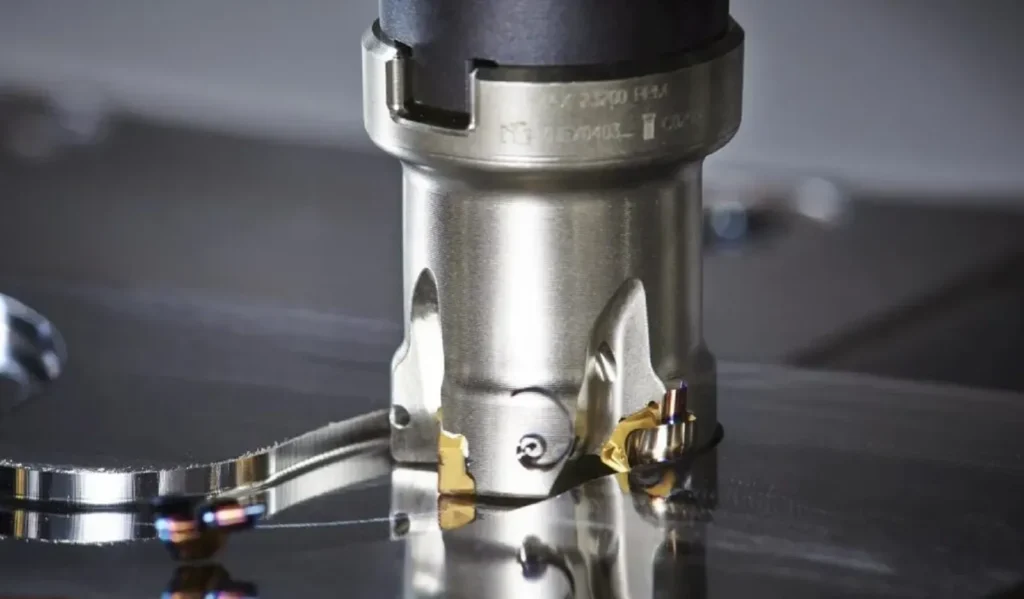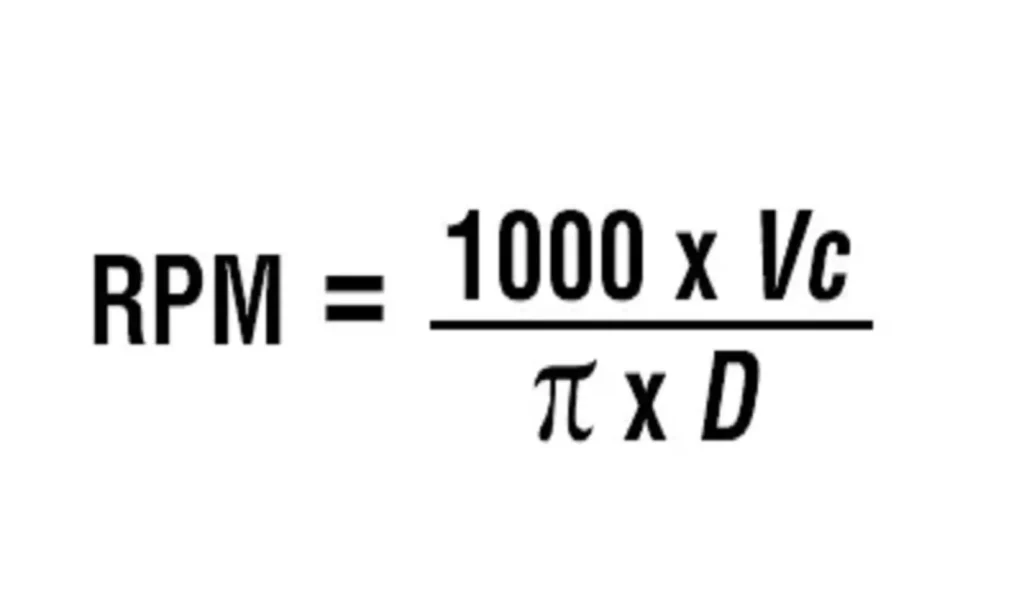在金屬加工的世界裡,對各產業的製造商而言,達到鋼材零件完美的表面光潔度是一個重要的目標。在這個追求過程中,其中一個關鍵因素就是選擇最佳的刀片半徑來精加工銑削鋼材。這個經常被忽略的刀具問題,會對成品品質、刀具壽命及整體生產力產生重大影響。在本綜合指南中,我們將探討刀片半徑選擇的複雜性,並提供您優化鋼材精加工製程的知識。

瞭解銑削加工中的刀片半徑
在深入探討精銑鋼材最佳刀片半徑的具體細節之前,必須先瞭解刀片半徑在銑削作業中的意義。刀片半徑是指銑削刀片切削刃的曲率。此半徑在決定刀具與工件之間的互動方面扮演重要角色,並影響切削力、切屑形成及表面精加工品質等因素。
插入半徑的類型包括
- 尖銳(零半徑)
- 小半徑 (通常為 0.2-0.8 mm)
- 中等半徑 (0.8-1.6 mm)
- 大半徑 (1.6 mm 及以上)
每種類型都有自己的優點和理想應用,因此選擇過程對達到最佳效果至關重要。
影響精銑鋼材最佳刀片半徑的因素
選擇精銑鋼材的最佳刀片半徑並非一刀切。在決定特定應用的最佳半徑時,有幾個因素會起作用:
- 鋼材特性與成分:不同的鋼種有不同的硬度、延展性及微觀結構,這些都會影響理想的刀片半徑。
- 切削參數:切削速度、進給率和切削深度等因素與刀片半徑相互影響,進而影響銑削過程。
- 機器能力:銑床的剛性和強度可以限制或擴大刀片半徑的選擇。
- 表面粗糙度要求:所需的表面粗糙度和公差規格將引導您選擇刀片半徑。
了解這些因素對於做出最適合您鋼材精加工作業的刀片半徑的明智決策至關重要。
鋼材精加工的最佳刀片半徑範圍
儘管精銑鋼材的特定最佳刀片半徑會因上述因素而異,但有一些一般建議可以作為最佳化的起點:
- 對於一般的鋼材精加工作業,刀片半徑在 0.4 mm 到 1.2 mm 之間通常是合適的。
- 較軟的鋼材可以使用較小的半徑 (0.4-0.8 mm) 來達到較細的表面光潔度。
- 硬度較高的鋼材通常需要較大的半徑 (0.8-1.2 mm) 以承受增加的切削力。
需要注意的是,這些範圍並非絕對,要達到最佳效果,必須根據您的特定要求和條件進行微調。
選擇正確插入半徑的好處
選擇最佳的刀片半徑來精銑鋼材具有許多優點:
- 改善表面光潔度:正確的半徑可大幅提升加工表面的平滑度與品質。
- 延長刀具壽命:正確的半徑選擇可減少切削刃的磨損,使刀片壽命更長。
- 提高生產力:最佳化的刀片半徑可以在不犧牲表面品質的情況下提高進給率,進而提升整體效率。
- 降低切削力:正確的半徑可將切削力降至最低,減少刀具和機器的應力。
- 更好的切屑控制:適當的刀片半徑有助於適當的切屑形成與排出,避免切屑重切等問題。
常見挑戰與解決方案
即使在精銑鋼材時仔細選擇最佳的刀片半徑,仍可能會遇到挑戰。以下是一些常見的問題及可能的解決方案:
- 喋喋不休和震動:
- 問題:過度振動導致表面處理不良。
- 解決方案:考慮增加刀片半徑或調整切削參數以降低切削力。
- 刀具偏移:
- 問題:刀具彎曲導致尺寸不準確。
- 解決方案:選擇較小的刀片半徑,或透過較短的懸伸或較硬的刀把來增加刀具剛性。
- 晶片控制:
- 問題:排屑不良導致表面缺陷或刀具損壞。
- 解決方案:試驗不同的刀片半徑和斷屑槽幾何形狀,以最佳化切屑形成。
選擇插入半徑的最佳做法
為了確保您使用最佳的刀片半徑來精銑鋼材,請考慮下列最佳實務:
- 諮詢工具製造商:利用他們的專業知識和資源來引導您的初步選擇。
- 進行徹底的測試:使用不同的刀片半徑進行控制測試,找出表面光潔度、刀具壽命和生產力之間的最佳平衡點。
- 監控和調整:持續評估績效,並準備根據實際結果進行調整。
- 考慮整個刀具系統:刀片半徑只是等式的一部分。確保與刀柄、機器及整體設定的相容性。
- 平衡取捨:認識到表面光潔度品質、刀具壽命和生產力之間可能會有所取捨。根據您的具體需求來排定優先順序。
個案研究:成功實現最佳刀片半徑
為了說明選擇最佳刀片半徑對精銑鋼材的影響,我們來看看兩個實際案例:
- 汽車產業範例:一家高性能引擎零件製造商正苦於鋼製汽缸套的表面粗糙度不一致。透過將刀片半徑從 0.4 mm 最佳化至 0.8 mm,他們的表面品質改善了 30%,刀具壽命增加了 25%。
- 航太應用:一家航太零件供應商需要提高其鋼渦輪葉片銑削製程的效率。透過謹慎選擇1.2 mm的刀片半徑,他們在維持所需表面光潔度的同時,進給率提高了40%,大幅提升生產力。
這些範例說明了針對特定鋼材精加工應用找到最佳刀片半徑的實際效益。
插入半徑技術的未來趨勢
隨著製造技術的不斷進步,我們可以預期將會有更多的創新技術,進一步精進精銑鋼材最佳刀片半徑的選擇過程:
- 先進塗層:新的塗層技術可以在不犧牲刀具壽命的情況下,使刀片半徑更大。
- 客製化刀片幾何形狀:製造商可針對特定鋼種及加工需求,提供更專門的刀片設計。
- AI 驅動的最佳化:機器學習演算法可根據感測器資料和歷史效能,提供插入半徑調整的即時建議。
- 混合半徑設計:刀片沿切削刃的半徑可變,可針對不同的切削條件提供更多的通用性。
總結
選擇最佳的銑削刀片半徑是優化製程的重要一環。了解半徑選擇的影響因素、認識適當優化的好處,並遵循最佳實務,就能大幅改善鋼材精加工作業。
請記住,尋找理想的刀片半徑通常是一個反覆的過程,需要仔細考慮您的特定需求和條件。持續評估及改善您的方法,以確保在表面加工品質、刀具壽命及整體生產力方面,都能達到最佳效果。
隨著技術的不斷發展,請隨時瞭解刀片設計和銑削技術的最新發展。結合您的專業知識與尖端工具和方法,您將能夠自信且精準地處理最具挑戰性的鋼材精加工任務。


